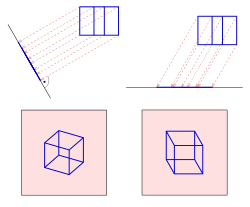Parallel projection
In linear algebra and functional analysis, a projection is a linear transformation P from a vector space to itself such that P2 = P. Projections map the whole vector space to a subspace and leave the points in that subspace unchanged.[1]
Parallel Projection Media
Comparison of several types of graphical projection. The presence of one or more 90° principal angles is usually a good indication that the perspective is oblique.
Example of a trimetric projection showing the shape of the Bank of China Tower in Hong Kong.
Notes
- ↑ Meyer, pp 386+387
References
- N. Dunford and J.T. Schwartz, Linear Operators, Part I: General Theory, Interscience, 1958.
- Carl D. Meyer, Matrix Analysis and Applied Linear Algebra, Society for Industrial and Applied Mathematics, 2000. ISBN 978-0-89871-454-8.
Other websites
- MIT Linear Algebra Lecture on Projection Matrices Archived 2008-12-20 at the Wayback Machine at Google Video, from MIT OpenCourseWare









